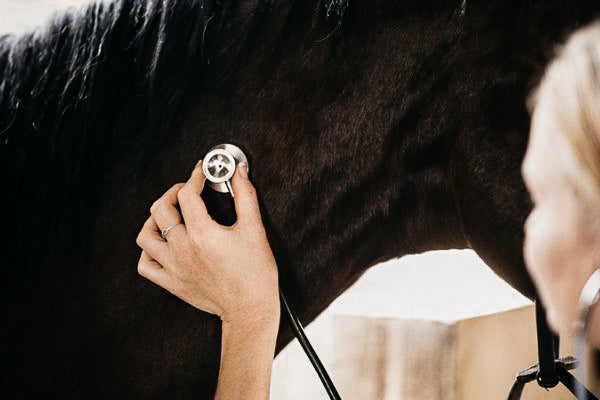
Druse in horses – necessary information in an emergency
We all want healthy horses. But unfortunately we keep hearing about news from riding stables where diseases such as strangles have broken out.
A big shock for the owners of the animals and the stable operators. The affected herd is quarantined, those who become ill receive immediate veterinary care and ultimately all that remains is to hope for the best for the animals.
What exactly is strangles? How do you recognize horse disease and how can you help your horse? Valid questions. We want to try to explain to you the most important facts about strangles disease in horses.
Druse - briefly explained
The strangles are diseases of the respiratory organs. The trigger for the infection is streptococci in horses. These nasty things are highly contagious! So if a horse suffers from this condition, it is inevitable that other animals will become ill. In the worst case, it can affect the entire stable. However, strangles in horses do not need to be reported.
This horse disease has actually been around since time immemorial. It would be inappropriate to accuse anyone here. Because: If it really breaks out, you have to stick together and get through it together. Immediate veterinary care included of course!
Old or young horses with weaker immune systems are particularly at risk for this disease. But also healthy animals that experience a lot of stress (e.g. b Tournaments, transports.) exposed can become ill. The bacterium can even survive in the stable and not break out. A strong immune system can definitely block the strangles disease. People cannot get sick from it.
Course of horse disease strangles
As already explained, Streptococcus equi is the culprit. This strain of bacteria is very survivable and can survive for days in the stable, on the meadow or in the paddock. It can live on even in water.
Transmission:
- from horse to horse (when sick animals cough, they snort the bacteria up to 40 - 50 meters away)
- from free-roaming dogs and cats
- Bacteria stick everywhere (clothing, shoes, fur.)
Strangles have an incubation period of three days to two weeks after contact with the bacterial matter. The streptococci then attack the horse's lymph nodes and form abscesses with purulent secretion. The result is severe swelling (sometimes leading to shortness of breath = tracheotomy necessary). If this bursts, all the snot is emptied through the air sac and nose. This is usually cleaned again as the animal recovers.
Unfortunately, the abscess can also rupture outward through the skin in the parotid area. Not nice. Going to the horse clinic is always the best choice. The secretions secreted contain enormous pathogens and are highly contagious! If action is not taken early enough or the animal has a fundamentally poor constitution, the horse disease can be fatal.
Gland symptoms:
- Your horse seems limp and listless
- The animal has a lot of nasal discharge (green to yellowish)
- Fever in horses (often very high temperature)
- Cough
- Severely swollen lymph nodes are a warning sign (you can find them at the level of the ganache in the lower jaw area)
- Difficulty swallowing
- Your horse has little to no appetite
Diagnosis of strangles in horses
Your first to do if you suspect this disease is to contact the veterinarian (or horse clinic) quickly.
The first thing he will do is carry out a basic examination of your sweetheart.
This means that he observes the horse's breathing (normal value at rest: 8 - 12 puffs/minute) and uses a thermometer to measure the body temperature (normal value at rest: 37.5 - 38.2 degrees Celsius) to see whether the horse has a fever. He also listens to the lungs with his stethoscope. Tapping the organ often helps him to detect mucus formation. This also includes palpating the lymph nodes.
But the most important thing for identifying strangles is a secretion sample. This bacteriological examination is essential!
These samples are possible in Germany via LABOKLIN . But your vet knows this and will definitely act quickly. The laboratory test shows which germs are plaguing your horse.
Don't worry - it doesn't have to be the case that the horse's strangles have broken out straight away. Maybe your partner just has a simple cold, which the vet can treat well.
In the event of an outbreak of strangles, your doctor will probably resort to a strong penicillin, order an absolute quarantine and inform you in detail about what will happen next. He will also order your stable to undergo extensive disinfection. This must be adhered to for weeks/months!
Unfortunately, strangles treatment in horses can take a long time. A mashed potato wrap (warm) on the affected areas of the neck provides some relief. This is a recipe from grandma's time - but it's actually supposed to help with this horse disease. 80-90% of the animals recover. The rest? You don't want to think about it. Positive thoughts please!
Vaccines against the disease are possible prophylactically (e.g. b for new hires), but whether the vaccination covers “the” bacterial strain is questionable. The best precaution is and remains: meeting all of your horse's needs (high-quality feed throughout the day, lots of unrestricted exercise in the fresh air, regular training, clean bedding, contact with other horses and loving care).
Discover more posts

In today's equestrian sports, the saddle plays an enormously important role for horse and rider. The selection of horse saddles is incredibly large - whether dressage saddles or jumping saddle...
Continue reading
The Shetland Pony – small person, big heart
The Shetland pony is immediately associated with the term “pony”: small, sweet, cheeky and voracious. Everyone knows it and everyone likes it. But the affectionately called Shetty is not just ...
Continue reading
